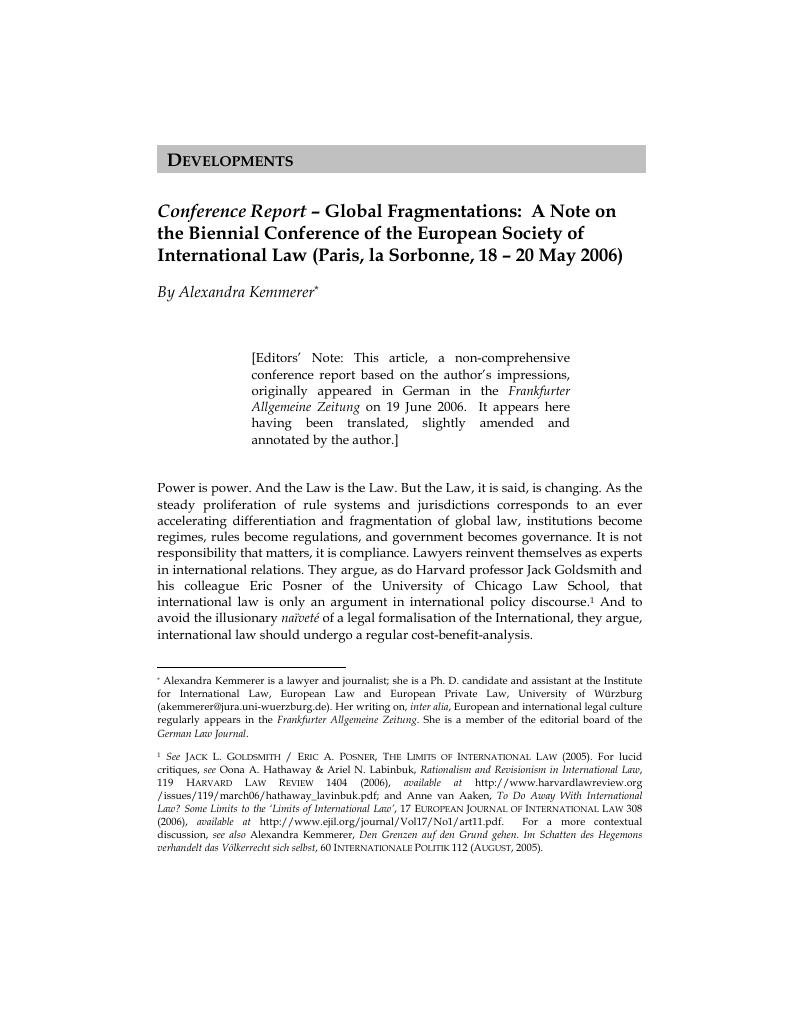Published online by Cambridge University Press: 06 March 2019

1 See Goldsmith, Jack L. / Posner, Eric A., The Limits of International Law (2005). For lucid critiques, see Hathaway, Oona A. & Labinbuk, Ariel N., Rationalism and Revisionism in International Law, 119 Harvard Law Review 1404 (2006), available at http://www.harvardlawreview.org/issues/119/march06/hathaway_lavinbuk.pdf; and van Aaken, Anne, To Do Away With International Law? Some Limits to the ‘Limits of International Law’, 17 European Journal of International Law 308 (2006), available at http://www.ejil.org/journal/Vol17/No1/art11.pdf. For a more contextual discussion, see also Kemmerer, Alexandra, Den Grenzen auf den Grund gehen. Im Schatten des Hegemons verhandelt das Völkerrecht sich selbst, 60 Internationale Politik 112 (August, 2005).Google Scholar
2 See Goodwin, Morag and Kemmerer, Alexandra, As Sounding Brass, or a Tinkling Cymbal? Reflections on the Inaugural Conference of the European Society of International Law, 5 German Law Journal 849 (2004), at http://www.germanlawjournal.com/article.php?id=461. For a report on the first ESIL/SEDI research forum (Geneva 2005), see MacDonald, Euan, Some Reflections on the European Society of International Law Research Forum 2005, in 6 German Law Journal 1209 (2005), at www.germanlawjournal.com/pdf/Vol06No08/PDF_Vol_06_No_08_12091216_Developments_Macdonald.pdf.Google Scholar
3 Arendt, Hannah, The Human Condition (1958).Google Scholar
4 On Kennedy's critique, see also Kennedy, David, The Dark Side of Virtue: Reassessing International Humanitarianism (2004).Google Scholar
5 As lawyers tend to be reluctant to look too closely into the substructures of the normative power of facts, it comes as no surprise that that notion was coined by a political scientist. See Nye, Joseph, Soft Power. The Means to Success in World Politics (2004).Google Scholar
6 On her approach, see also Delmas-Marty, Mireille, Le pluralisme ordonné. Les forces imaginantes du droit II (2006); Delmas-Marty, Mireille, Le relatif et l'universel. Les forces imaginantes du droit (2004).Google Scholar
7 While the debate on questions of a constitutionalisation of international law proliferates, the key arguments are still to be found in Fassbender, Bardo, The United Nations Charter as Constitution of the International Community, 36 Columbia Journal of Transnational Law 529 (1998); Frowein, Jochen Abr., Konstitutionalisierung des Völkerrechts, 39 Bericht der Deutschen Gesellschaft für Völkerrecht - Völkerrecht und Internationales Recht in einem sich globalisierenden internationalen System 427 (2000); and Paulus, Andreas, Die Internationale Gemeinschaft im Völkerrecht: Eine Untersuchung zur Entwicklung des Völkerrechts im Zeitalter der Globalisierung (2000). See also Habermas, Jürgen, Hat die Konstitutionalisierung des Völkerrechts noch eine Chance?, in Der gespaltene Westen 113 (2004); and Bryde, Brun-Otto, Das Völkerrecht zwischen Konstitutionalisierung, Hegemonie und Renationalisierung, in Die Zukunft des Völkerrechts in einer globalisierten Welt 88 (Heinrich-Böll-Stiftung, ed., 2006). For a critique of contemporary generalisations and “legal unity thinking,” see, e.g., Teubner, Gunther, Societal Constitutionalism: Alternatives to State-Centred Constitutional Theory?, in Transnational Governance and Constitutionalism 3 (Joerges, Christian, et al. eds., 2004); and Fischer-Lescano, Andreas & Teubner, Gunther, Regime-Kollisionen. Zur Fragmentierung des globalen Rechts 10 - 24 (2006).Google Scholar
8 Quite surprisingly, no one among the panelists or from the audience engaged the moderator, Chairman of the International Law Commission's Study Group on the Fragmentation of International Law, in a discussion about the findings regarding the elaboration of an “international law of conflicts” that was laid out in his final report, published on 4 April 2006 and currently under consideration at the ILC's 58th session (Geneva, 1 May - 9 June and 3 July - 11 August 2006). See Koskenniemi, Martti, Fragmentation of International Law: Difficulties Arising from the Diversification and Expansion of International Law. Report of the Study Group of the International Law Commission, UN Doc A/CN.4/L.682 (1 August 2002), available at http://www.helsinki.fi/oik/globalgovernance/Mallisivusto/tutkimus/untitled/A%20CN4%20L682%5B1%5D.pdf.Google Scholar
9 The next biennial conference will be held in 2008 in Heidelberg.Google Scholar
10 For a thorough examination of the legal status of NGOs in international law, placed within a wider discussion on the representation of groups in the international legal system, see also Lindblom, Anna-Karin, Non-Governmental Organisations in International Law (2005).Google Scholar
11 See Zumbansen, Peer, Transnational Law, in Encyclopedia of Comparative Law 738 (Smits, Jan ed., 2006); and, of course, Jessup, Philip's strikingly timeless observations: Jessup, Philip C., Transnational Law (1956).Google Scholar
12 For some reflections on this phenomenon, see Kemmerer, Alexandra, On the Use and Abuse … International Law's Historical Turn, in Progress in International Organization (Miller, Russell A. and Bratspies, Rebecca eds., forthcoming 2007).Google Scholar